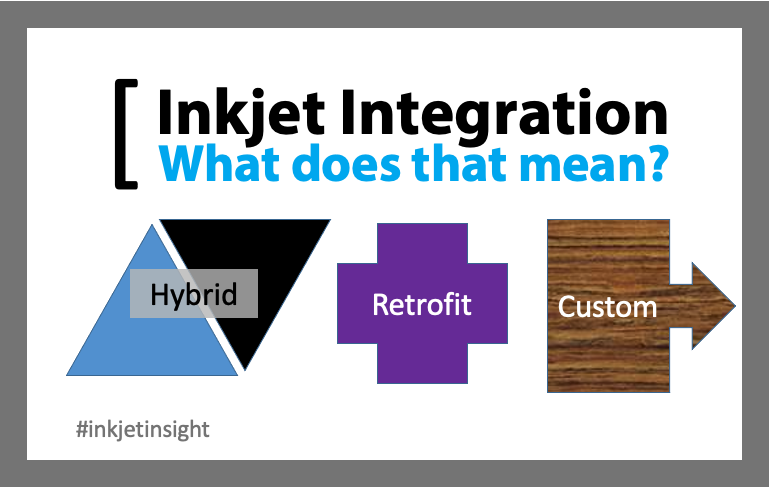There’s a big inkjet market out there that involves everyone from Inkjet OEMs and component manufacturers to product brands in food, fashion and decor with a whole lot of printing companies in between. This market isn’t about buying (or building) the same press as the guy down the street. It’s about doing something new with equipment you have, putting multiple processes together, or building something new with inkjet to meet a specific business need – and that need may not even be related to the print industry. If it seems like this covers a lot of ground – it does. The short hand for this market is “Inkjet Integration” but it is very loosely defined and there is a lot of overlap between the buyers of services and the companies that are part of the supply chain.
You will find inkjet integrators working in print-on-paper markets, labels and packaging, industrial, textiles, 3D printing and many other areas. The results of their work may be called hybrid, bespoke, custom, retrofit or nothing at all because the only ones who know about the solution are the customers they were designed for. At Inkjet Insight, we believe that there are tremendous opportunities for growth in this market. We would like to foster this growth by making it easier for companies investigating custom solutions to find solution providers and for the various players in the solution ecosystem to find each other. In order to make that happen, we are conducting a series of surveys designed for buyers and sellers of these services. The published research will be available for free on our site.
Research on Buyers of Custom Inkjet and Inkjet Integration Services
Our first survey is for buyers of services and will take 10-15 minutes to complete. If you are a past or potential buyer of inkjet integration services, please take our survey. Those who complete the survey will be entered in a drawing to win one of 10 $50 Amazon gift cards (we wish we could give a present to all of you.) Even if you don’t get one of the gift cards, you will be rewarded with valuable research findings and our appreciation.
If you don’t fit the target audience for this survey, don’t fret. You can still help us by sharing this post or forwarding the link to people you know who are buyers of inkjet products and integration services such as commercial printing companies and brands/companies integrating inkjet printing into their product manufacturing or packaging process. OEMs who use integration partners are also included in this audience.
Integrators should not complete this survey unless they also use inkjet for their in-house projects. However, we will soon have a second survey geared to integrators available. If you want to be contacted when the second survey is availableIf please email help@inkjetinsight with the subject line: Survey.


Comments
This is an excellent article. Just want to point out that finishing of inkjeted production is different, because each piece is different.
Therefore you often need to batch based on the inkjeted content.
Most inkjet hardware has the ability to output one or more electrical signals based on a notation in the data-base.
The most common useage is to separate product on USPS mail tray breaks. You can also print a mark instead or also.
These electrical signals can for example:
~ jog a sheet to the side, so it can be found in the stack
~ drive a solenoid into a shingled stream
or speed up a conveyor so a break is created in the material flow.
The point is to automate down-stream processing/finishing.
Inkjet often requires drying. Which often means evaporating water.
Some times hair-dryers can be used, or a radiant foot-warmer. It’s important that the heater is not glowing Red type, but instead Black (invisible) radiation type.
Water drying is 6x faster with Black-Heat. Technically known as 940Nanometer (Not NIR, Near-Infrared)
Always have a Visable Light whenever the dryer is on … to warn the operator to not reach into the dryers area.
I’m glad you enjoyed the post, Buck. We’re hoping that people interested in the topic of integration (from the buying side) will take the time to complete our latest survey for which a link is included at the end of the article.